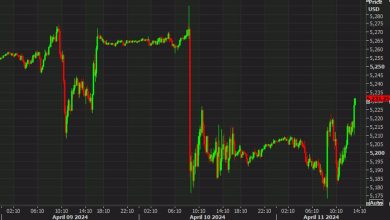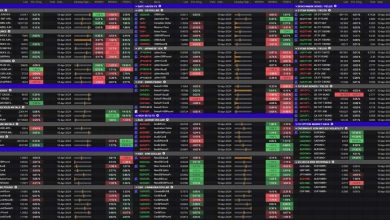Forexlive Americas FX News Summary April 19. The Nasdaq is having its worst week since

Today, the focus has been on large-cap technology stocks. The Nasdaq index cried out with a drop of -2.05%. This is the biggest decline since January 31, when the index fell -2.23%. The decline was initially driven by disappointing guidance from Netflix following its earnings announcement after Thursday’s close. Its shares fell -9.09%.
The downward push was pushed back, just before public company Super Micro Computers announced its earnings date, but did not announce its fiscal third-quarter results in advance. SMCI was one of the darlings of the first quarter, alongside Nvidia. According to sources, in seven of the last eight quarters, the company has issued a press release announcing preliminary results before its usual earnings release, typically raising its financial guidance. This would not have been the case today and the stock fell sharply in response. This momentum continued during the US session, with the stock plunging 23.16% to $713.65. The Q1 high price reached $1,229.00. The decline. Nvidia too. Its shares fell $84.31, or -10.0%, to $762.
BTW Super Micro Computers will announce its results on April 30. Nvidia won’t announce until May 22
Other big players today include a number of different chip stocks:
- AMD, – 5.44%.
- Micro-4.61%
- Broadcom -4.31%
- Metaplatforms -4.13%
- CrowdStrike stakes -3.99%
- Taiwanese semiconductor -3.46%
- Amazon -2.56%
- Intel -2.40%
- Qualcomm-2.36%
- Tesla, -1.92%.
Next week, the results calendar kicks into full gear. Below is a sampling of some of the major earnings releases. :
- Monday: Verizon, SAP
- Tuesday: GM, Tesla, Visa, Texas Instruments
- Wednesday: Boeing, AT&T, General Dynamics, Meta Platforms, IBM, Ford, Chipotle, ServiceNow
- Thursday: American Airlines, Caterpillar, Southwest Airlines, Bristol-Myers Squibb, Microsoft, Alphabet, Intel
- Friday: Exxon Mobil, Chevron
Today, in the US debt market, yields are falling slightly.
- 2-year yield, 4.99%, unchanged
- 5-year yield 4.671%, -1.6 basis points
- 10-year yield 4.622%, -2.4 basis points
- 30-year yield 4.715% -2.9 basis points
During the trading week, yields rose as markets reacted to the Fed’s rate shift to stable rates for longer:
- 2-year yield +8.7 basis points
- 5-year yield +11.4 basis points
- 10-year yield +9.7 basis points
- Yield at 30 years +8.3 basis points
A snapshot of the foreign exchange market at the end of the week shows that the CHF is the strongest of the major currencies thanks to a bid for safety.
The GBP was the weakest. BOE Ramsden commented:
- Over the past few months, I have become more confident in the evidence that risks to persistence and domestic inflationary pressures are fading.
- The balance of domestic risks to the UK inflation outlook is now tilted to the downside.
This helped push GBPUSD lower and the pair fell to the lowest level of the year, dating back to November 14. The price is also testing the 61.8% rise from the October 2023 low at 1.23635, and the high. from a swing zone dating back to the first quarter of 2023 at 1.2368. GBPUSD low price today reached 1.2366.
The Fed’s Goolsbee closed Fedspeak ahead of the quiet period (the Fed is scheduled to announce the next time on May 1). Goolsbee discussed the current state of the U.S. economy, highlighting the stalled progress on inflation and arguing for a cautious approach to interest rates until more clarity is achieved. He said the Federal Reserve’s current tight monetary policy remains appropriate, but stressed that future policy adjustments will be data-driven. Goolsbee highlighted the continuing challenge posed by high housing inflation and noted that it was possible to improve services inflation through an increase in labor supply. He questioned whether high GDP and employment figures could indicate an overheating economy contributing to inflationary pressures, while acknowledging that not all data suggests an overheating labor market. Although the Fed has managed to keep unemployment low, it has struggled to fulfill its inflation mandate. Goolsbee warned against maintaining a high level of restrictions for too long due to potential negative impacts on employment. He described the policy tradeoffs as increasingly complex and noted that the real federal funds rate is historically high. Optimistically, he projected that inflation would return to the 2% target over a reasonable period, and he did not rule out any policy options, including rate hikes if necessary, to manage economic conditions.
Meanwhile, ECB officials, including Lagarge, today. Muller and Wunsch advocate multiple rate cuts starting in June.
US core PCE data will be released on Friday and will be key to the Fed’s future outlook.
cnbctv18-forexlive





